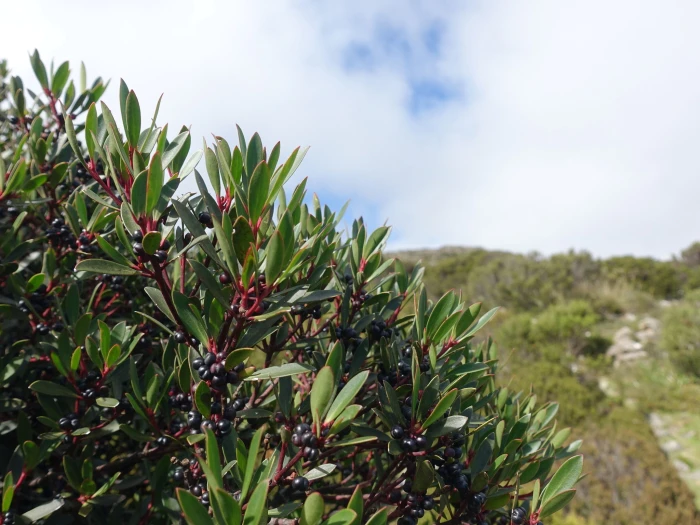Tasmanian Pepperberry
(Tasmannia lanceolata)
Tasmanian Pepperberry (Tasmannia lanceolata)
/
/

Cowirrie
Public Domain
Image By:
Cowirrie
Recorded By:
Copyright:
Public Domain
Copyright Notice:
Photo by: Cowirrie | License Type: Public Domain | License URL: http://creativecommons.org/publicdomain/zero/1.0/ | Rights Holder: Cowirrie | Publisher: iNaturalist | Date Created: 2017-04-02T12:06:08-07:00 |































Estimated Native Range
Climate Requirements for Abilene, Texas
| This Plant | Your Site | Plant Suitability for Your Location | ||
|---|---|---|---|---|
| • Precipitation | 7" - 112" | 24" | Your precipitation may be insufficient for this plant. Irrigate N" / year. | Irrigate N" / year |
| • High Temp. | 58°F - 101°F | 95°F | Your summer temperatures are normal for this plant. | Excellent |
| • Low Temp. | 17°F - 46°F | 31°F | Your winter temperatures are normal for this plant | Excellent |
This plant should grow well at your location with about N inches per year (Y minutes per month) of irrigation.
Summary
Tasmannia lanceolata, commonly known as Tasmanian pepperberry or mountain pepper, is an evergreen shrub native to the cool temperate rainforests and the margins of wet sclerophyll forests in Tasmania and southeastern Australia. It varies in size from 2 to 10 meters high and features aromatic leaves and red stems. The small, cream or white flowers bloom in summer and are not particularly showy, but they give way to distinctive black, globose, two-lobed berries 5–8 mm wide in autumn. These berries are notable for their culinary use as a spice when dried.
Tasmanian pepperberry is valued for its ornamental foliage, aromatic leaves, and the culinary appeal of its berries. It is used in gardens for its attractive appearance and as a spice plant. The berries also provide food for birds such as Currawongs. It is suitable for border planting, as a feature shrub, or in a mixed shrubbery. Tasmannia lanceolata requires well-drained acidic soil and can tolerate some shade, although it thrives in full sun to part shade with medium water requirements. Popular garden cultivars include ’Mt. Wellington’, which is a compact plant with coppery new growth, and ’Suzette’, a variegated cultivar. While generally easy to maintain, it can be susceptible to root rot in poorly drained soils. It is not known to be invasive outside its native range but should be monitored to ensure it does not become problematic.CC BY-SA 4.0
Tasmanian pepperberry is valued for its ornamental foliage, aromatic leaves, and the culinary appeal of its berries. It is used in gardens for its attractive appearance and as a spice plant. The berries also provide food for birds such as Currawongs. It is suitable for border planting, as a feature shrub, or in a mixed shrubbery. Tasmannia lanceolata requires well-drained acidic soil and can tolerate some shade, although it thrives in full sun to part shade with medium water requirements. Popular garden cultivars include ’Mt. Wellington’, which is a compact plant with coppery new growth, and ’Suzette’, a variegated cultivar. While generally easy to maintain, it can be susceptible to root rot in poorly drained soils. It is not known to be invasive outside its native range but should be monitored to ensure it does not become problematic.CC BY-SA 4.0
Plant Description
- Plant Type: Shrub
- Height: 3-10 feet
- Width: 3-10 feet
- Growth Rate: Slow
- Flower Color: Yellow, Cream
- Flowering Season: Spring
- Leaf Retention: Evergreen
Growth Requirements
- Sun: Full Sun, Part Shade
- Water: Medium
- Drainage: Medium
Common Uses
Deer Resistant, Drought Tolerant, Edible*Disclaimer: Easyscape's listed plant edibility is for informational use. Always verify the safety and proper identification of any plant before consumption., Fragrant, Salt Tolerant, Street Planting
Natural Habitat
Native to cool temperate rainforests and the margins of wet sclerophyll forests in Tasmania and southeastern Australia
Other Names
Common Names: Tasmanian Pepperberry
Scientific Names: Tasmannia lanceolata, Drimys lanceolata, Drimys aromatica, Tasmannia aromatica, Winterana lanceolata, Austrodrimys lanceolata, Drimys xerophila var. aromatica, Wintera lanceolata
GBIF Accepted Name: Drimys aromatica (R.Br.) F.Muell.